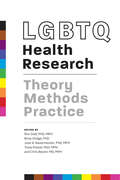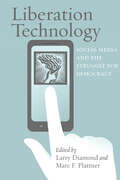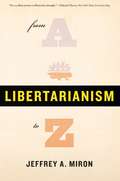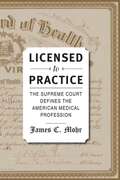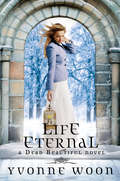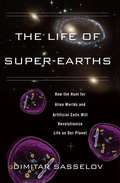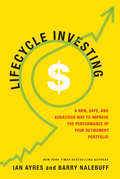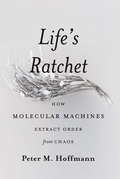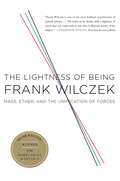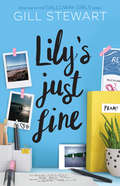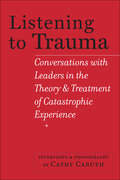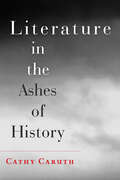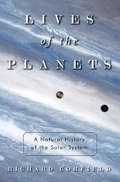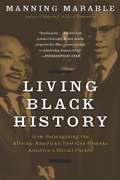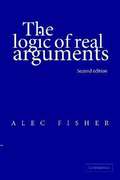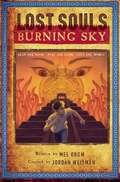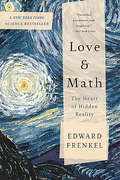- Table View
- List View
LGBTQ Health Research: Theory, Methods, Practice
by Ron Stall PHD, MPH, et al.Over the last 30 years, the health needs of lesbian, gay, bisexual, transgender, and queer Americans have become increasingly recognized, in particular for the ways in which they are distinct from those typically assessed and addressed in society. Universities and researchers are paying greater attention to LGBTQ public health issues and how they might adapt existing methods to research marginalized communities, but—until now—there has been no authoritative resource to guide their education or practice. Developed for graduate students in public health and health sciences—but perfect for anyone interested in this topic—this book will fill that gap and provide the necessary public health tools to teach about and study LGBTQ populations effectively. Divided into three sections and edited by top scholars, LGBTQ Health Research explains research methods important to descriptive epidemiology that are needed to document health disparities among LGBTQ populations. The book also examines research methods that help explain the driving forces of these disparities. Focusing on real-world experience in developing and testing interventions to mitigate health disparities in LGBTQ populations, it also breaks down issues that challenge the direct application of standard research methods with these communities, including those related to sampling, measurement, choice of theoretical variables to explain the distribution of health and illness, cultural competence in intervention design, and community participation.Promoting the creation and diffusion of effective interventions, the book takes a holistic approach to address longstanding research gaps regarding important marginalized communities. It also documents profound health disparities in many LBGTQ populations across a wide range of health conditions and explains why future development of the field must be based on inclusive science and rigorous research methods. LGBTQ Health Research is an essential textbook for any courses that deal with the intersection of marginalization, health, sexuality, and gender.Contributors: José A. Bauermeister, Chris Beyrer, Kerith Conron, Brian Dodge, Rita Dwan, Stephen L. Forssell, Peter Gamache, Gary W. Harper, Mark L. Hatzenbuehler, Colleen Hoff, Carl Latkin, Ilan H. Meyer, Robin Lin Miller, Angulique Y. Outlaw, Christopher Owens, Tonia Poteat, Erin Riley, Joshua Rosenberger, Ayden I. Scheim, Shauna Stahlman, Randall Sell, Ron Stall, Rob Stephenson, Rachel Strecher, Ryan C. Tingler, Karin E. Tobin, Ronald O. Valdiserri, and Richard J. Wolitski
LGBTQ Health Research: Theory, Methods, Practice
by Ron Stall Brian Dodge José A. Bauermeister Tonia Poteat Chris BeyrerOver the last 30 years, the health needs of lesbian, gay, bisexual, transgender, and queer Americans have become increasingly recognized, in particular for the ways in which they are distinct from those typically assessed and addressed in society. Universities and researchers are paying greater attention to LGBTQ public health issues and how they might adapt existing methods to research marginalized communities, but—until now—there has been no authoritative resource to guide their education or practice. Developed for graduate students in public health and health sciences—but perfect for anyone interested in this topic—this book will fill that gap and provide the necessary public health tools to teach about and study LGBTQ populations effectively. Divided into three sections and edited by top scholars, LGBTQ Health Research explains research methods important to descriptive epidemiology that are needed to document health disparities among LGBTQ populations. The book also examines research methods that help explain the driving forces of these disparities. Focusing on real-world experience in developing and testing interventions to mitigate health disparities in LGBTQ populations, it also breaks down issues that challenge the direct application of standard research methods with these communities, including those related to sampling, measurement, choice of theoretical variables to explain the distribution of health and illness, cultural competence in intervention design, and community participation.Promoting the creation and diffusion of effective interventions, the book takes a holistic approach to address longstanding research gaps regarding important marginalized communities. It also documents profound health disparities in many LBGTQ populations across a wide range of health conditions and explains why future development of the field must be based on inclusive science and rigorous research methods. LGBTQ Health Research is an essential textbook for any courses that deal with the intersection of marginalization, health, sexuality, and gender.Contributors: José A. Bauermeister, Chris Beyrer, Kerith Conron, Brian Dodge, Rita Dwan, Stephen L. Forssell, Peter Gamache, Gary W. Harper, Mark L. Hatzenbuehler, Colleen Hoff, Carl Latkin, Ilan H. Meyer, Robin Lin Miller, Angulique Y. Outlaw, Christopher Owens, Tonia Poteat, Erin Riley, Joshua Rosenberger, Ayden I. Scheim, Shauna Stahlman, Randall Sell, Ron Stall, Rob Stephenson, Rachel Strecher, Ryan C. Tingler, Karin E. Tobin, Ronald O. Valdiserri, and Richard J. Wolitski
Liberation Technology: Social Media and the Struggle for Democracy (A Journal of Democracy Book)
by Larry Diamond Marc F. PlattnerThe revolutions sweeping the Middle East provide dramatic evidence of the role that technology plays in mobilizing citizen protest and upending seemingly invulnerable authoritarian regimes. A grainy cell phone video of a Tunisian street vendor’s self-immolation helped spark the massive protests that toppled longtime ruler Zine El Abidine Ben Ali, and Egypt’s "Facebook revolution" forced the ruling regime out of power and into exile. While such "liberation technology" has been instrumental in freeing Egypt and Tunisia, other cases—such as China and Iran—demonstrate that it can be deployed just as effectively by authoritarian regimes seeking to control the Internet, stifle protest, and target dissenters. This two-sided dynamic has set off an intense technological race between "netizens" demanding freedom and authoritarians determined to retain their grip on power.Liberation Technology brings together cutting-edge scholarship from scholars and practitioners at the forefront of this burgeoning field of study. An introductory section defines the debate with a foundational piece on liberation technology and is then followed by essays discussing the popular dichotomy of "liberation" versus "control" with regard to the Internet and the sociopolitical dimensions of such controls. Additional chapters delve into the cases of individual countries: China, Egypt, Iran, and Tunisia.This book also includes in-depth analysis of specific technologies such as Ushahidi—a platform developed to document human-rights abuses in the wake of Kenya’s 2007 elections—and alkasir—a tool that has been used widely throughout the Middle East to circumvent cyber-censorship.Liberation Technology will prove an essential resource for all students seeking to understand the intersection of information and communications technology and the global struggle for democracy.Contributors: Walid Al-Saqaf, Daniel Calingaert, Ronald Deibert, Larry Diamond, Elham Gheytanchi, Philip N. Howard, Muzammil M. Hussain, Rebecca MacKinnon, Patrick Meier, Evgeny Morozov, Xiao Qiang, Rafal Rohozinski, Mehdi Yahyanejad
Liberation Technology: Social Media and the Struggle for Democracy (A Journal of Democracy Book)
by Larry Diamond Marc F. PlattnerThe revolutions sweeping the Middle East provide dramatic evidence of the role that technology plays in mobilizing citizen protest and upending seemingly invulnerable authoritarian regimes. A grainy cell phone video of a Tunisian street vendor’s self-immolation helped spark the massive protests that toppled longtime ruler Zine El Abidine Ben Ali, and Egypt’s "Facebook revolution" forced the ruling regime out of power and into exile. While such "liberation technology" has been instrumental in freeing Egypt and Tunisia, other cases—such as China and Iran—demonstrate that it can be deployed just as effectively by authoritarian regimes seeking to control the Internet, stifle protest, and target dissenters. This two-sided dynamic has set off an intense technological race between "netizens" demanding freedom and authoritarians determined to retain their grip on power.Liberation Technology brings together cutting-edge scholarship from scholars and practitioners at the forefront of this burgeoning field of study. An introductory section defines the debate with a foundational piece on liberation technology and is then followed by essays discussing the popular dichotomy of "liberation" versus "control" with regard to the Internet and the sociopolitical dimensions of such controls. Additional chapters delve into the cases of individual countries: China, Egypt, Iran, and Tunisia.This book also includes in-depth analysis of specific technologies such as Ushahidi—a platform developed to document human-rights abuses in the wake of Kenya’s 2007 elections—and alkasir—a tool that has been used widely throughout the Middle East to circumvent cyber-censorship.Liberation Technology will prove an essential resource for all students seeking to understand the intersection of information and communications technology and the global struggle for democracy.Contributors: Walid Al-Saqaf, Daniel Calingaert, Ronald Deibert, Larry Diamond, Elham Gheytanchi, Philip N. Howard, Muzammil M. Hussain, Rebecca MacKinnon, Patrick Meier, Evgeny Morozov, Xiao Qiang, Rafal Rohozinski, Mehdi Yahyanejad
Libertarianism, from A to Z
by Jeffrey A. MironLibertarian principles seem basic enough—keep government out of boardrooms, bedrooms, and wallets, and let markets work the way they should. But what reasoning justifies those stances, and how can they be elucidated clearly and applied consistently? In Libertarianism, from A to Z, acclaimed Harvard economist Jeffrey Miron sets the record straight with a dictionary that takes the reader beyond the mere surface of libertarian thought to reveal the philosophy&’s underlying and compelling logic. Tackling subjects as diverse as prostitution and drugs, the financial crises and the government bailouts, the legality of abortion, and the War on Terror, Miron takes the reader on a tour of libertarian thought. He draws on consequentialist principles that balance the costs and benefits of any given government intervention, emphasizing personal liberty and free markets. Miron never flinches from following those principles to their logical and sometimes controversial ends. Along the way, readers get a charming and engaging lesson in how to think like a libertarian. Principled, surprising, and thought provoking, Libertarianism, from A to Z, has everything a bourgeoning libertarian—or any responsible citizen—needs to know.
Licensed to Practice: The Supreme Court Defines the American Medical Profession
by James C. MohrLicensed to Practice begins with an 1891 shooting in Wheeling, West Virginia, that left one doctor dead and another on trial for his life. Formerly close friends, the doctors had fallen out over the issue of medical licensing. Historian James C. Mohr calls the murder "a sorry personal consequence of the far larger and historically significant battle among West Virginia’s physicians over the future of their profession."Through most of the nineteenth century, anyone could call themselves a doctor and could practice medicine on whatever basis they wished. But an 1889 U.S. Supreme Court case, Dent v. West Virginia, effectively transformed medical practice from an unregulated occupation to a legally recognized profession. The political and legal battles that led up to the decision were unusually bitter—especially among physicians themselves—and the outcome was far from a foregone conclusion.So-called Regular physicians wanted to impose their own standards on the wide-open medical marketplace in which they and such non-Regulars as Thomsonians, Botanics, Hydropaths, Homeopaths, and Eclectics competed. The Regulars achieved their goal by persuading the state legislature to make it a crime for anyone to practice without a license from the Board of Health, which they controlled. When the high court approved that arrangement—despite constitutional challenges—the licensing precedents established in West Virginia became the bedrock on which the modern American medical structure was built. And those precedents would have profound implications. Thus does Dent, a little-known Supreme Court case, influence how Americans receive health care more than a hundred years after the fact.
Licensed to Practice: The Supreme Court Defines the American Medical Profession
by James C. MohrLicensed to Practice begins with an 1891 shooting in Wheeling, West Virginia, that left one doctor dead and another on trial for his life. Formerly close friends, the doctors had fallen out over the issue of medical licensing. Historian James C. Mohr calls the murder "a sorry personal consequence of the far larger and historically significant battle among West Virginia’s physicians over the future of their profession."Through most of the nineteenth century, anyone could call themselves a doctor and could practice medicine on whatever basis they wished. But an 1889 U.S. Supreme Court case, Dent v. West Virginia, effectively transformed medical practice from an unregulated occupation to a legally recognized profession. The political and legal battles that led up to the decision were unusually bitter—especially among physicians themselves—and the outcome was far from a foregone conclusion.So-called Regular physicians wanted to impose their own standards on the wide-open medical marketplace in which they and such non-Regulars as Thomsonians, Botanics, Hydropaths, Homeopaths, and Eclectics competed. The Regulars achieved their goal by persuading the state legislature to make it a crime for anyone to practice without a license from the Board of Health, which they controlled. When the high court approved that arrangement—despite constitutional challenges—the licensing precedents established in West Virginia became the bedrock on which the modern American medical structure was built. And those precedents would have profound implications. Thus does Dent, a little-known Supreme Court case, influence how Americans receive health care more than a hundred years after the fact.
Life Eternal (A Dead Beautiful Novel #2)
by Yvonne WoonThe dark, romantic sequel to Dead Beautiful from Yvonne Woon.Renée Winters has changed. When she looks in the mirror, a beautiful girl with an older, sadder face stares back. Her condition has doctors mystified, but Renée can never reveal the truth: she died last May, and was brought back to life by the kiss of her Undead soul mate, Dante Berlin. Now, her separation from Dante becomes almost unbearable. His second life is close to an end, and each passing day means one less that she will spend with the boy who shares her soul. Just when Renée has almost given up hope, she learns of the Nine Sisters—brilliant scholars who, according to legend, found a way to cheat death. She can&’t shake the feeling that they are somehow connected to her dreams, strange visions that hint at a discovery so powerful, and so dangerous, that some will stop at nothing to protect it. Renée thought she knew the truth about life and death. But there is a secret woven through history that holds the only hope for Dante and Renée. Unless they find answers soon, their time together is doomed to be cut short....
The Life of Super-Earths: How the Hunt for Alien Worlds and Artificial Cells Will Revolutionize Life on Our Planet
by Dimitar SasselovIn 1543, Nicolaus Copernicus fomented a revolution when he debunked the geocentric view of the universe, proving instead that our planet wasn&’t central to the universe. Almost five hundred years later, the revolution he set in motion is nearly complete. Just as earth is not the center of things, the life on it, it appears, is not unique to the planet. Or is it? The Life of Super-Earths is a breathtaking tour of current efforts to answer the age-old question: Are we alone in the universe? Astronomer Dimitar Sasselov, the founding director of Harvard University&’s Origins of Life Initiative, takes us on a fast-paced hunt for habitable planets and alien life forms. He shows how the search for &“super-Earths&”—rocky planets like our own that orbit other stars—may provide the key to answering essential questions about the origins of life here and elsewhere. That is, if we don&’t find the answers to those questions here first. As Sasselov and other astronomers have uncovered planets with mixes of elements different from our own, chemists have begun working out the heretofore unseen biochemistries that those planets could support. That knowledge is feeding directly into synthetic biology—the effort to build wholly novel forms of life—making it likely that we will first discover truly &“alien&” life forms in an earthly lab, rather than on a remote planet thousands of light years away. Sasselov tells the gripping story of a moment of unprecedented potential—a convergence of pioneering efforts in astronomy and biology to peer into the unknown. The Life of Super-Earths offers nothing short of a transformation in our understanding of life and its place in the cosmos.
Lifecycle Investing: A New, Safe, and Audacious Way to Improve the Performance of Your Retirement Portfolio
by Ian Ayres Barry NalebuffDiversification provides a well-known way of getting something close to a free lunch: by spreading money across different kinds of investments, investors can earn the same return with lower risk (or a much higher return for the same amount of risk). This strategy, introduced nearly fifty years ago, led to such strategies as index funds. What if we were all missing out on another free lunch that&’s right under our noses? In Lifecycle Investing, Barry Nalebuff and Ian Ayres—two of the most innovative thinkers in business, law, and economics—have developed tools that will allow nearly any investor to diversify their portfolios over time. By using leveraging when young—a controversial idea that sparked hate mail when the authors first floated it in the pages of Forbes—investors of all stripes, from those just starting to plan to those getting ready to retire, can substantially reduce overall risk while improving their returns. In Lifecycle Investing, readers will learnHow to figure out the level of exposure and leverage that&’s right for youHow the Lifecycle Investing strategy would have performed in the historical marketWhy it will work even if everyone does itWhen not to adopt the Lifecycle Investing strategy Clearly written and backed by rigorous research, Lifecycle Investing presents a simple but radical idea that will shake up how we think about retirement investing even as it provides a healthier nest egg in a nicely feathered nest.
Life's Ratchet: How Molecular Machines Extract Order from Chaos
by Peter M. HoffmannThe cells in our bodies consist of molecules, made up of the same carbon, oxygen, and hydrogen atoms found in air and rocks. But molecules, such as water and sugar, are not alive. So how do our cells—assemblies of otherwise &“dead&” molecules—come to life, and together constitute a living being? In Life&’s Ratchet, physicist Peter M. Hoffmann locates the answer to this age-old question at the nanoscale. The complex molecules of our cells can rightfully be called &“molecular machines,&” or &“nanobots&”; these machines, unlike any other, work autonomously to create order out of chaos. Tiny electrical motors turn electrical voltage into motion, tiny factories custom-build other molecular machines, and mechanical machines twist, untwist, separate and package strands of DNA. The cell is like a city—an unfathomable, complex collection of molecular worker bees working together to create something greater than themselves. Life, Hoffman argues, emerges from the random motions of atoms filtered through the sophisticated structures of our evolved machinery. We are essentially giant assemblies of interacting nanoscale machines; machines more amazing than can be found in any science fiction novel. Incredibly, the molecular machines in our cells function without a mysterious &“life force,&” nor do they violate any natural laws. Scientists can now prove that life is not supernatural, and that it can be fully understood in the context of science. Part history, part cutting-edge science, part philosophy, Life&’s Ratchet takes us from ancient Greece to the laboratories of modern nanotechnology to tell the story of our quest for the machinery of life.
Life's Ratchet: How Molecular Machines Extract Order from Chaos
by Peter M HoffmannLife is an enduring mystery. Yet, science tells us that living beings are merely sophisticated structures of lifeless molecules. If this view is correct, where do the seemingly purposeful motions of cells and organisms originate? In Life's Ratchet, physicist Peter M. Hoffmann locates the answer to this age-old question at the nanoscale. Below the calm, ordered exterior of a living organism lies microscopic chaos, or what Hoffmann calls the molecular storm -- specialized molecules immersed in a whirlwind of colliding water molecules. Our cells are filled with molecular machines, which, like tiny ratchets, transform random motion into ordered activity, and create the "purpose" that is the hallmark of life. Tiny electrical motors turn electrical voltage into motion, nanoscale factories custom-build other molecular machines, and mechanical machines twist, untwist, separate and package strands of DNA. The cell is like a city -- an unfathomable, complex collection of molecular workers working together to create something greater than themselves. Life, Hoffman argues, emerges from the random motions of atoms filtered through these sophisticated structures of our evolved machinery. We are agglomerations of interacting nanoscale machines more amazing than anything in science fiction. Rather than relying on some mysterious "life force" to drive them -- as people believed for centuries -- life's ratchets harness instead the second law of thermodynamics and the disorder of the molecular storm. Grounded in Hoffmann's own cutting-edge research, Life's Ratchet reveals the incredible findings of modern nanotechnology to tell the story of how the noisy world of atoms gives rise to life itself.
The Lightness of Being: Mass, Ether, and the Unification of Forces
by Frank WilczekA Nobel-prize winning physicist takes on the essential question: what are we made of?Our understanding of nature's deepest reality has changed radically, but almost without our noticing, over the past twenty-five years. Transcending the clash of older ideas about matter and space, acclaimed physicist Frank Wilczek explains a remarkable new discovery: matter is built from almost weightless units, and pure energy is the ultimate source of mass. He calls it "The Lightness of Being." Space is no mere container, empty and passive. It is a dynamic Grid-a modern ether- and its spontaneous activity creates and destroys particles. This new understanding of mass explains the puzzling feebleness of gravity, and a gorgeous unification of all the forces comes sharply into focus.The Lightness of Being is the first book to explore the implications of these revolutionary ideas about mass, energy, and the nature of "empty space." In it, Wilczek masterfully presents new perspectives on our incredible universe and envisions a new golden age of fundamental physics.
Lily's Just Fine (Galloway Girls #1)
by Gill StewartLily couldn’t have planned life better herself. She lives in the best house in town and she’s dating the most popular boy in school. Everything else she can fix. Mum’s apathy? On it! The stuffy gala committee? Watch this space! Tom has enough on his plate without trying to drag Newton St Cuthbert into the 21st Century. His sister is sick and there’s nothing anyone can do. Not doctors, not his parents, and certainly not Lily Hildebrand. About the Galloway Girls series:Set in the west coast of Scotland, Galloway Girls is a contemporary YA series with a touch of romance. Newfound friendships and unexpected summer romances arise as four teens plan their futures and face adulthood. Summery and light-hearted while dealing with relatable teen issues such as family relationships and mental wellbeing, Galloway Girls is perfect for girls 14+ and fans of Lucy Powrie, Stephanie Perkins and Jenny Han.
Listening to Trauma: Conversations with Leaders in the Theory and Treatment of Catastrophic Experience
by Cathy CaruthThis new collection from Cathy Caruth features interviews with a diverse group of leaders in the theorization of, and response to, traumatic experience in the twentieth and twenty-first centuries. Crossing the boundaries of discipline and profession, Caruth’s subjects include literary theorists and critics, psychoanalysts, psychiatrists, psychologists, political activists, filmmakers, public intellectuals, institutional leaders, and researchers. Exploring the intertwining of the intellectual and personal dimensions of experience, each interview is accompanied by Caruth's intimate photographic portrait of its subject. Caruth chose her subjects because of their impact on her thinking as well as their significant role as witnesses to the collective and cultural significance of trauma. The individuals profiled here are innovators in the theory of trauma (Part I), in the clinical, activist, or testimonial interventions in trauma (Part II), or in the creation or modification of institutions that provide therapeutic, artistic, or legal responses to traumatic events (Part III). Two of the interviews first appeared in Caruth's landmark 1995 work, Trauma: Explorations in Memory. The rest were conducted between 2011 and 2013 after the field of trauma studies expanded significantly. Representing both the foundation of trauma research and cutting-edge approaches to the topic, this collection will be useful to practitioners with an interest in post-traumatic stress disorder as well as scholars exploring the multiple dimensions of profound human experience.A portion of the proceeds from sales of this book will go to the Grady Nia Project for abused, suicidal, and low-income African American women.
Listening to Trauma: Conversations with Leaders in the Theory and Treatment of Catastrophic Experience
by Cathy CaruthThis new collection from Cathy Caruth features interviews with a diverse group of leaders in the theorization of, and response to, traumatic experience in the twentieth and twenty-first centuries. Crossing the boundaries of discipline and profession, Caruth’s subjects include literary theorists and critics, psychoanalysts, psychiatrists, psychologists, political activists, filmmakers, public intellectuals, institutional leaders, and researchers. Exploring the intertwining of the intellectual and personal dimensions of experience, each interview is accompanied by Caruth's intimate photographic portrait of its subject. Caruth chose her subjects because of their impact on her thinking as well as their significant role as witnesses to the collective and cultural significance of trauma. The individuals profiled here are innovators in the theory of trauma (Part I), in the clinical, activist, or testimonial interventions in trauma (Part II), or in the creation or modification of institutions that provide therapeutic, artistic, or legal responses to traumatic events (Part III). Two of the interviews first appeared in Caruth's landmark 1995 work, Trauma: Explorations in Memory. The rest were conducted between 2011 and 2013 after the field of trauma studies expanded significantly. Representing both the foundation of trauma research and cutting-edge approaches to the topic, this collection will be useful to practitioners with an interest in post-traumatic stress disorder as well as scholars exploring the multiple dimensions of profound human experience.A portion of the proceeds from sales of this book will go to the Grady Nia Project for abused, suicidal, and low-income African American women.
Literature in the Ashes of History
by Cathy CaruthCathy Caruth juxtaposes the writings of psychoanalysts, literary and political theorists, and literary authors who write in a century faced by a new kind of history, one that is made up of events that seem to undo, rather than produce, their own remembrance. At the heart of each chapter is the enigma of a history that, in its very unfolding, seems to be slipping away before our grasp. What does it mean for history to disappear? And what does it mean to speak of a history that disappears? These questions, Caruth suggests, lie at the center of the psychoanalytic texts that frame this book, as well as the haunting stories and theoretical arguments that resonate with each other in profound and surprising ways. In the writings of Honoré de Balzac, Hannah Arendt, Ariel Dorfman, Wilhelm Jensen, Sigmund Freud, and Jacques Derrida, we encounter, across different stakes and different languages, a variety of narratives that bear witness not simply to the past but also to the pasts we have not known and that repeatedly return us to a future that remains beyond imagination.These stories of trauma cannot be limited to the catastrophes they name, and the theory of catastrophic history may ultimately be written in a language that already lingers in a time that comes to us from the other side of the disaster.
Literature in the Ashes of History
by Cathy CaruthCathy Caruth juxtaposes the writings of psychoanalysts, literary and political theorists, and literary authors who write in a century faced by a new kind of history, one that is made up of events that seem to undo, rather than produce, their own remembrance. At the heart of each chapter is the enigma of a history that, in its very unfolding, seems to be slipping away before our grasp. What does it mean for history to disappear? And what does it mean to speak of a history that disappears? These questions, Caruth suggests, lie at the center of the psychoanalytic texts that frame this book, as well as the haunting stories and theoretical arguments that resonate with each other in profound and surprising ways. In the writings of Honoré de Balzac, Hannah Arendt, Ariel Dorfman, Wilhelm Jensen, Sigmund Freud, and Jacques Derrida, we encounter, across different stakes and different languages, a variety of narratives that bear witness not simply to the past but also to the pasts we have not known and that repeatedly return us to a future that remains beyond imagination.These stories of trauma cannot be limited to the catastrophes they name, and the theory of catastrophic history may ultimately be written in a language that already lingers in a time that comes to us from the other side of the disaster.
Lives of the Planets: A Natural History of the Solar System
by Richard CorfieldLives of the Planets describes a scientific field in the midst of a revolution. Planetary science has mainly been a descriptive science, but it is becoming increasingly experimental. The space probes that went up between the 1960s and 1990s were primarily generalists-they collected massive amounts of information so that scientists could learn what questions to pursue. But recent missions have become more focused: Scientists know better what information they want and how to collect it. Even now probes are on their way to Mercury, Venus, Mars, and Pluto, with Europa-one of Jupiter's moons-on the agenda. In a sweeping look into the manifold objects inhabiting the depths of space, Lives of the Planets delves into the mythology and the knowledge humanity has built over the ages. Placing our current understanding in historical context, Richard Corfield explores the seismic shifts in planetary astronomy and probes why we must change our perspective of our place in the universe. In our era of extraordinary discovery, this is the first comprehensive survey of this new understanding and the history of how we got here.
Living Black History: How Reimagining the African-American Past Can Remake America's Racial Future
by Manning MarableAre the stars of the Civil Rights firmament yesterday's news? In Living Black History scholar and activist Manning Marable offers a resounding "No!” with a fresh and personal look at the enduring legacy of such well-known figures as Malcolm X, Martin Luther King, Jr., Medgar Evers and W.E.B. Du Bois. Marable creates a "living history” that brings the past alive for a generation he sees as having historical amnesia. His activist passion and scholarly memory bring immediacy to the tribulations and triumphs of yesterday and reveal that history is something that happens everyday. Living Black History dismisses the detachment of the codified version of American history that we all grew up with. Marable's holistic understanding of history counts the story of the slave as much as that of the master; he highlights the flesh-and-blood courage of those figures who have been robbed of their visceral humanity as members of the historical cannon. As people comprehend this dynamic portrayal of history they will begin to understand that each day we-the average citizen-are "makers” of our own American history. Living Black History will empower readers with knowledge of their collective past and a greater understanding of their part in forming our future.
Living Black History: How Reimagining the African-American Past Can Remake America's Racial Future
by Manning MarableAre the stars of the Civil Rights firmament yesterday's news? In Living Black History scholar and activist Manning Marable offers a resounding "No!" with a fresh and personal look at the enduring legacy of such well-known figures as Malcolm X, Martin Luther King, Jr., Medgar Evers and W.E.B. Du Bois. Marable creates a "living history" that brings the past alive for a generation he sees as having historical amnesia. His activist passion and scholarly memory bring immediacy to the tribulations and triumphs of yesterday and reveal that history is something that happens everyday. Living Black History dismisses the detachment of the codified version of American history that we all grew up with. Marable's holistic understanding of history counts the story of the slave as much as that of the master; he highlights the flesh-and-blood courage of those figures who have been robbed of their visceral humanity as members of the historical cannon. As people comprehend this dynamic portrayal of history they will begin to understand that each day we-the average citizen-are "makers" of our own American history. Living Black History will empower readers with knowledge of their collective past and a greater understanding of their part in forming our future.
The Logic of Real Arguments (PDF)
by Alec FisherThis new and expanded edition of The Logic of Real Arguments explains a distinctive method for analysing and evaluating arguments, using examples ranging from newspaper articles to extracts from classic texts.
Lost Souls: Burning Sky
by Mel Odom Jordan WeismanIn this trilogy created by new media genius Jordan Weisman, the son of archeologists, Nathan is your typical kid--one of the smartest at his school, but fails at everything because he won't apply himself. Nathan is shocked when on his thirteenth birthday, he receives his birthright from the Mayan god Kukulkan: the ability to travel the frequencies and interact with spirits. The fate of the human race rests with Nathan, who must play a game with Kukulkan for the world's survival--all culminating with the end of the Mayan calendar on December 22, 2012. Now it is time for Nathan to use his newfound gifts, fulfill his potential, and save the world!
Love and Math: The Heart of Hidden Reality
by Edward FrenkelAn awesome, globe-spanning, and New York Times bestselling journey through the beauty and power of mathematicsWhat if you had to take an art class in which you were only taught how to paint a fence? What if you were never shown the paintings of van Gogh and Picasso, weren't even told they existed? Alas, this is how math is taught, and so for most of us it becomes the intellectual equivalent of watching paint dry.In Love and Math, renowned mathematician Edward Frenkel reveals a side of math we've never seen, suffused with all the beauty and elegance of a work of art. In this heartfelt and passionate book, Frenkel shows that mathematics, far from occupying a specialist niche, goes to the heart of all matter, uniting us across cultures, time, and space.Love and Math tells two intertwined stories: of the wonders of mathematics and of one young man's journey learning and living it. Having braved a discriminatory educational system to become one of the twenty-first century's leading mathematicians, Frenkel now works on one of the biggest ideas to come out of math in the last 50 years: the Langlands Program. Considered by many to be a Grand Unified Theory of mathematics, the Langlands Program enables researchers to translate findings from one field to another so that they can solve problems, such as Fermat's last theorem, that had seemed intractable before.At its core, Love and Math is a story about accessing a new way of thinking, which can enrich our lives and empower us to better understand the world and our place in it. It is an invitation to discover the magic hidden universe of mathematics.
Love and Math: The Heart of Hidden Reality
by Edward FrenkelAn awesome, globe-spanning, and New York Times bestselling journey through the beauty and power of mathematics What if you had to take an art class in which you were only taught how to paint a fence? What if you were never shown the paintings of van Gogh and Picasso, weren't even told they existed? Alas, this is how math is taught, and so for most of us it becomes the intellectual equivalent of watching paint dry. In Love and Math, renowned mathematician Edward Frenkel reveals a side of math we've never seen, suffused with all the beauty and elegance of a work of art. In this heartfelt and passionate book, Frenkel shows that mathematics, far from occupying a specialist niche, goes to the heart of all matter, uniting us across cultures, time, and space. Love and Math tells two intertwined stories: of the wonders of mathematics and of one young man's journey learning and living it. Having braved a discriminatory educational system to become one of the twenty-first century's leading mathematicians, Frenkel now works on one of the biggest ideas to come out of math in the last 50 years: the Langlands Program. Considered by many to be a Grand Unified Theory of mathematics, the Langlands Program enables researchers to translate findings from one field to another so that they can solve problems, such as Fermat's last theorem, that had seemed intractable before. At its core, Love and Math is a story about accessing a new way of thinking, which can enrich our lives and empower us to better understand the world and our place in it. It is an invitation to discover the magic hidden universe of mathematics.
